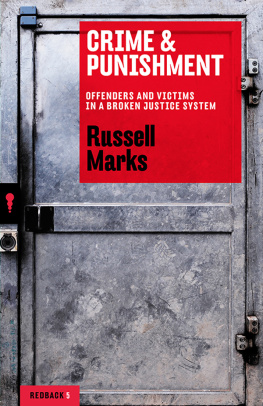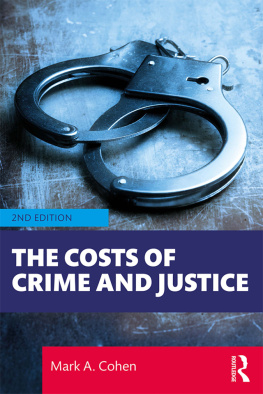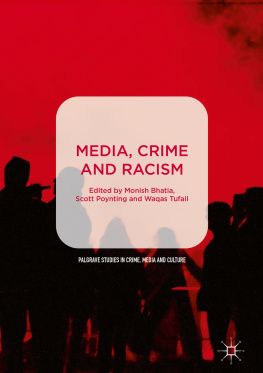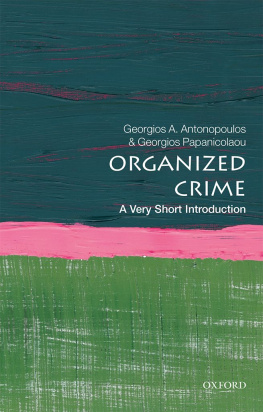Crime, Media, and Reality
Published by Rowman & Littlefield
A wholly owned subsidiary of The Rowman & Littlefield Publishing Group, Inc.
4501 Forbes Boulevard, Suite 200, Lanham, Maryland 20706
www.rowman.com
Unit A, Whitacre Mews, 2634 Stannary Street, London SE11 4AB
Copyright 2018 by Rowman & Littlefield
All rights reserved. No part of this book may be reproduced in any form or by any electronic or mechanical means, including information storage and retrieval systems, without written permission from the publisher, except by a reviewer who may quote passages in a review.
British Library Cataloguing in Publication Information Available
Library of Congress Cataloging-in-Publication Data
978-1-4422-6081-8 (cloth)
978-1-4422-6082-5 (electronic)
 The paper used in this publication meets the minimum requirements of American National Standard for Information SciencesPermanence of Paper for Printed Library Materials, ANSI/NISO Z39.481992.
The paper used in this publication meets the minimum requirements of American National Standard for Information SciencesPermanence of Paper for Printed Library Materials, ANSI/NISO Z39.481992.
Printed in the United States of America
To Mike and John, for all of the love and support they give us.
Acknowledgments
This book was conceptualized many years ago. However, we would like to thank Rowman & Littlefield editor Kathyrn Knigge who guided us through the organization of the book. Without her insights and patience we could not have completed the project. We would also like to thank Darrell Seigler, Ltd. for permission to include his photograph in this book.
Chapter 1
Introduction
A Touch of Reality
MEDIAS SOCIAL CONSTRUCTION OF CRIME AND JUSTICE
Crime and justice have always been topics of fascination for the American public, and media have made great attempts to give the public its fill. Media have always provided our knowledge of crime from early forms of news media, such as broadsheets and the penny press to crime entertainment, from theater to dime novels to current television crime dramas and movies. The media have provided the public with the most infamous and fascinating stories of crime and speedy justice. However, what is portrayed in the media hardly reflects reality.
If we were to take notes from the media, we would assume that most crime is very violent. In fact, we must assume that serial killing is an everyday occurrence and that terrorists are lurking everywhere ready to destroy the nation. We would also believe that police are incredibly capable of solving 99 percent of the crimes committed and that 99 percent of the suspects go to trial and are very quickly convicted and sent to prison. However, the reality is that most offenses are nonviolent and unknown to the police. Furthermore, police are often unable to gather the most useful forensic evidence due to lack of training or lack of resources. Moving further down the justice system, most cases involve plea bargaining based on eyewitness testimony and never go to trial. Finally, where convictions (i.e., guilty verdicts or pleas) are obtained, even though the United States is more likely to use incarceration than most other countries, most offenders receive probation or a community-based sentence. Understanding these facts, it is our goal to provide a scientific explanation of how crime and justice are portrayed in the media. We begin with major concepts and their definitions.
DEFINING MEDIA
People often make the mistake of referring to the media as if it were singular. The word media is actually the plural form of the word medium. Merriam-Webster Dictionary defines medium as a particular form or system of communication. When we refer to the term media, we are referring to all forms of news and entertainment media in its televised, radio, and print forms. These include televised, cinematic, internet, radio, newspapers, magazines, and books. Furthermore, we are referring to mass media in the sense that stories of crime and justice tend to be received from many forms of media at the time they occur and for some time after.
In 2012, when Trayvon Martin was killed by George Zimmerman because he was a suspicious young black male, television, print, and radio news covered the story on a daily basis (see Figure 1.1). The media took its audience from the crime to the arrest, to the trial, to the protest and the Black Lives Matter movement, to the afterlife of George Zimmerman. Yet, it was not only the news media that picked up the story. The music industry also addressed the death of Trayvon Martin along with the killings of other unarmed black males. Rapper YG released a rap song called Police Get Away with Murder in which he raps, Black males in a hoodie thats a target to them. In response to the police shooting of Michael Brown, YG raps, Well put our hands up and theyll still shoot motherfucker. World News Rapper released a song, titled Trayvon Martin Song, in which they sang,
I got young sons, so it touches deep
Ill pray for his parents tonight, when I go to sleep.
Racismit still exists
Eliminating hate would be my one wish.
Moving to print media, in 2014, Kenneth J. Fasching-Varner, Rema E. Reynolds, Katrice A. Albert, and Lori L. Martin published an edited book titled Trayvon Martin, Race, and American Justice. If you were to do a Google Books search using the name Trayvon Martin, you would obtain 16,400 hits, with the first 18 hits having Trayvon Martins name in the title. Social media also covered Trayvon Martins death in depth. In fact, the Black Lives Matter movement was started by one of the Martin family lawyers using social media. But how far do these stories reach? How often do the media reach their targets, what messages are they sending, and how effective are their messages?
Weblink 1.1
For a detailed timeline of the Trayvon Martin case, go to: http://www.cbsnews.com/news/trayvon-martin-shooting-a-timeline-of-events/.

Figure 1.1. Mug shot of George Zimmerman, 2012. John E. Polk Correctional Facility. Photo in the public domain.
MEDIA CONSUMPTION
In order to understand the reach of the media, one has to understand the idea of convergence in a digital age. According to Jospeh Turow, convergence is the ability of different media to easily interact with each other because they all deal with the information in the same digital form. Understanding convergence in an era of mass media and mass communication allows us to understand how a news story read online can be sent to a friend via Facebook, Twitter, or Instagram. This same story will probably include links to previous reports of the crime as well as to reports of similar crimes. The consumer can access these stories from a laptop, tablet, or a cell phone at any time.
Linked to convergence is the rather recent practice of allowing the audience to become involved in the development of news stories. That is, the audience went from being passive receivers to being active receivers. Because news has become a 24/7 industry and because online media have overtaken print media, large media conglomerates have to compete with smaller media companies who are now able to reach a much larger audience than before and with less money. In order to keep the audience engrossed, news agencies have allowed them to participate in news gathering by including Twitter posts or YouTube videos in their reporting. Within the movie and music industries consumers are able to stream more easily than if they were forced to go to the movies or the music store. Companies such as Netflix, Amazon, and Hulu allow consumers unlimited viewing of movies for a relatively small monthly fee. iTunes and Amazon are two corporations that bring music to the fingertips of the consumer, and companies such as Pandora, iHeart, and YouTube allow for free streaming.








 The paper used in this publication meets the minimum requirements of American National Standard for Information SciencesPermanence of Paper for Printed Library Materials, ANSI/NISO Z39.481992.
The paper used in this publication meets the minimum requirements of American National Standard for Information SciencesPermanence of Paper for Printed Library Materials, ANSI/NISO Z39.481992.